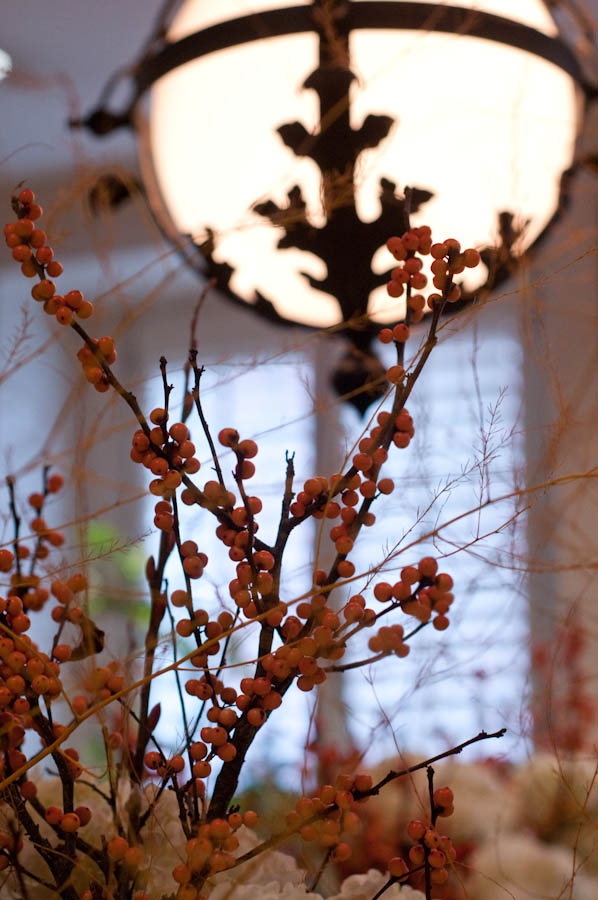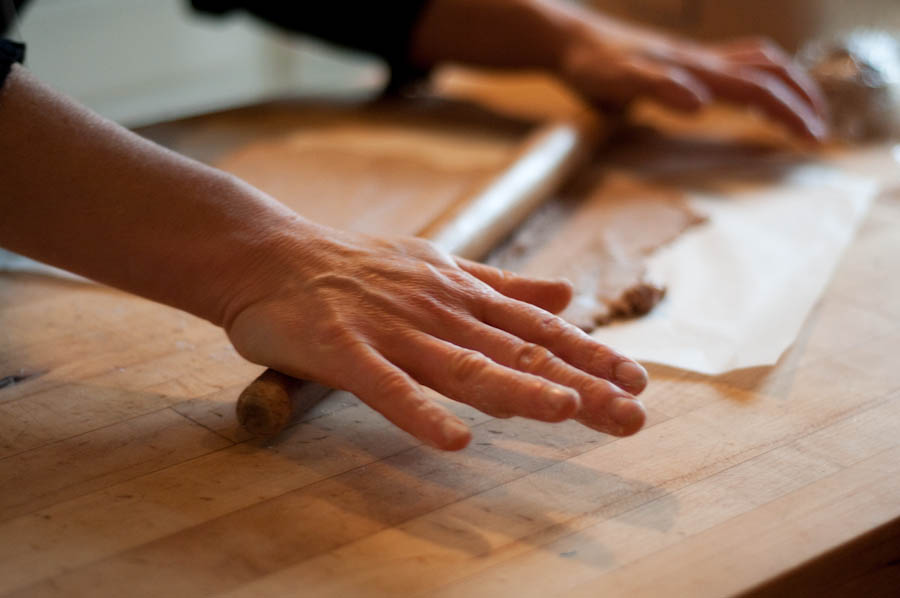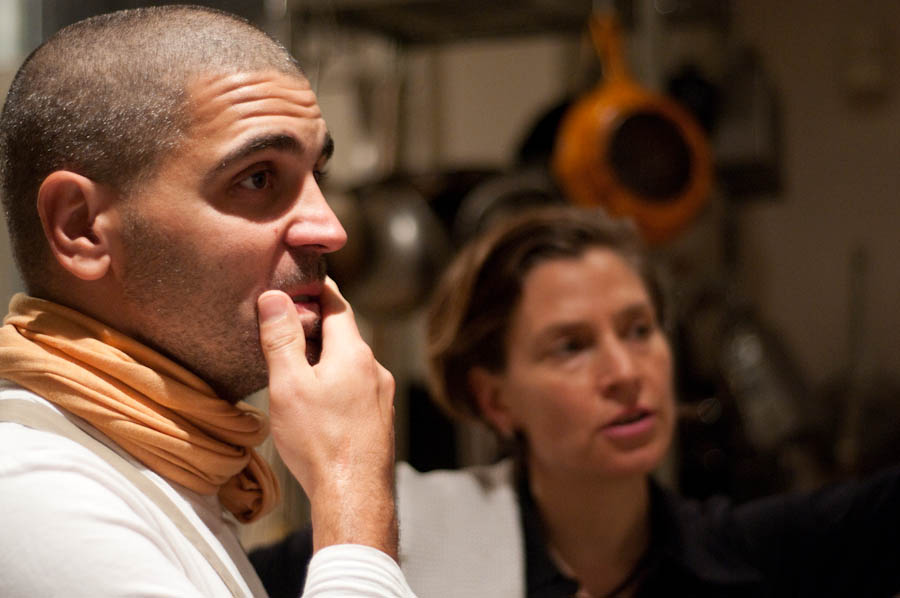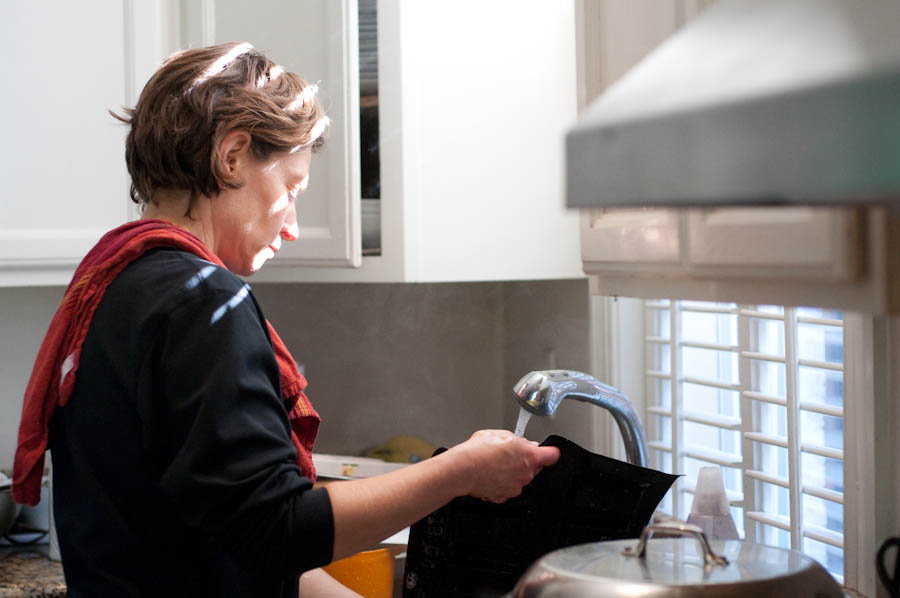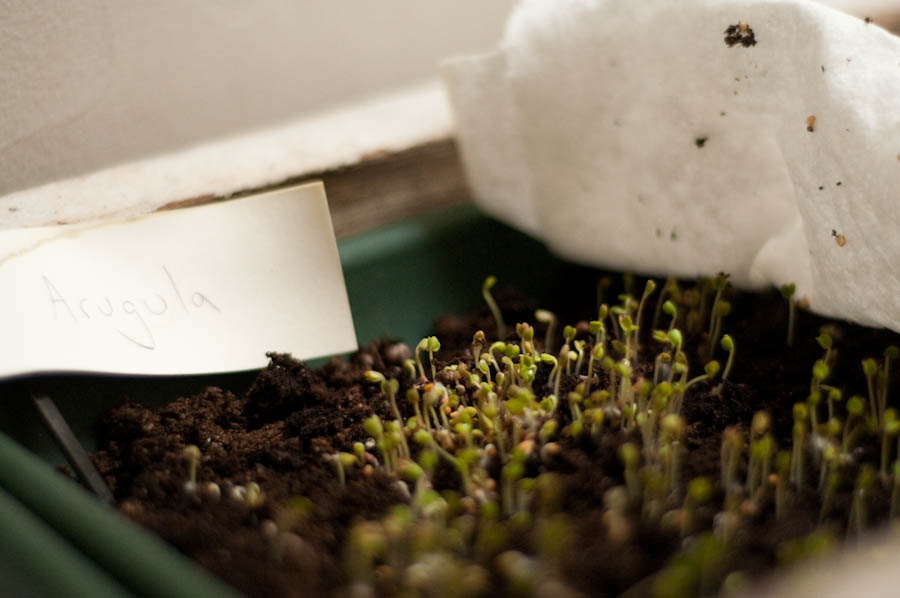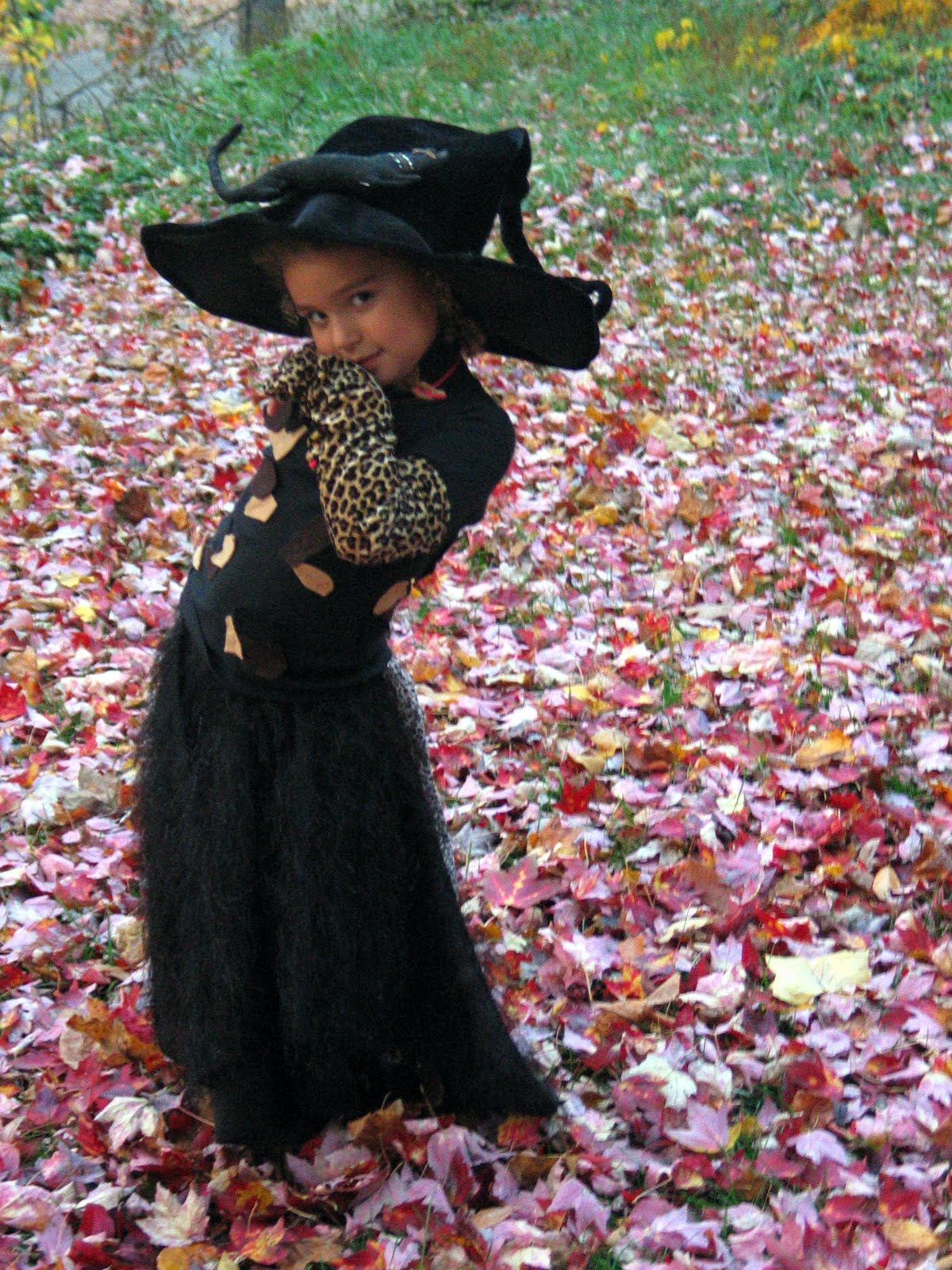Last weekend was very busy...we cooked for a Home Restaurant and a Brunch. We had two large flower jobs...All went very well. Jacqulyn Maisonneuve who has been photographing us for the last few months came by a few times over the last few days and spent the night here on Saturday night so she could capture the end of a dinner, awakening and an early morning of cooking. She said that when she shoots for a few hours she usually takes about 1000 photographs and then narrows that down to a few photos that she shares with us... which will be further edited down to about 10 photos that she will print and hang as her senior thesis at the Corcoran College of Art and Design early next year. Below are her photo picks from last weekend.
November 14, 2009 Home Restaurant
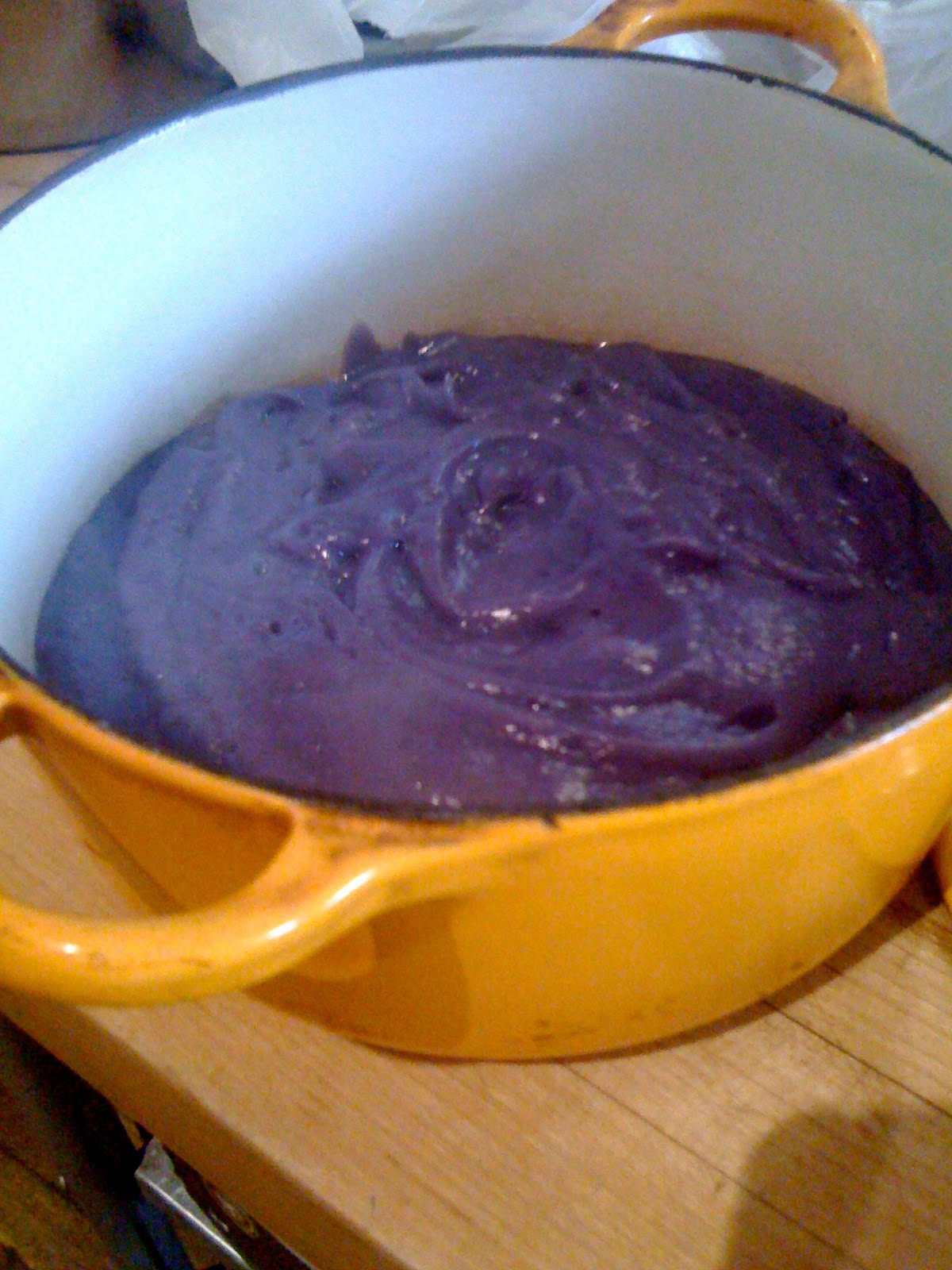 We had a lovely group of people here last night to celebrate their friends birthday. The birthday girl brought along her two young daughters, 10 and 12 years old, who were great diners and conversationalists. It was lots of fun sharing the fall bounty from our own backyard and nearby farms with this enthusiastic party.
We had a lovely group of people here last night to celebrate their friends birthday. The birthday girl brought along her two young daughters, 10 and 12 years old, who were great diners and conversationalists. It was lots of fun sharing the fall bounty from our own backyard and nearby farms with this enthusiastic party.
Tonight we started to sketch out next weekends menus...here is what we served last night...
Passing
Scallops on Corn Cake with Pickled Carrot
Chestnut Soup
Fall Squash Gratin with Tokyo Bekana Micro Greens
Roasted Apple and Onion
Potato Egg Salad with Neighbors Chives
Sorrel Martini
Domaine de Villargeau 2007, Appellation Coteaux du Glennois
Seated
Beef Bresaola with Girasole, Asian Pear, French Breakfast Radish and Napa Cabbage
(Cincinnato) ‘Raverosse’ Cori Rosso 2005
Hand Rolled Rigatoni with Baby Turnips, Tomato, Roasted Red Peppers and Oregon Chantarelles
(Buccia Nera) Toscano Bianco 'Donna Patrizia' 2008
Eco Friendly Foods Chicken Thigh with Oregon Black Truffle, Purple Cauliflower Puree, Roasted Sweet Potato and Broccoli Raab
(Pierre Gauthier) Bourgeuil "Vingt Lieux Dits" 2005
Cave Aged Marissa Cheese with Walnut Cracker
Shaved Carrot Ice with Toasted Coconut Flakes
(Roc des Anges) VDP “A” Passerille 2004
Warm Pear and Banana Crumble with Almond Sorbet
(Chancelle/Bourdin) Cremant de Saumur NV
Cookies:
Chocolate Chocolate Chip, Ginger Snap, Chocolate Chip and Lemon Poppy Seed
Wild vs. Farm Raised Salmon
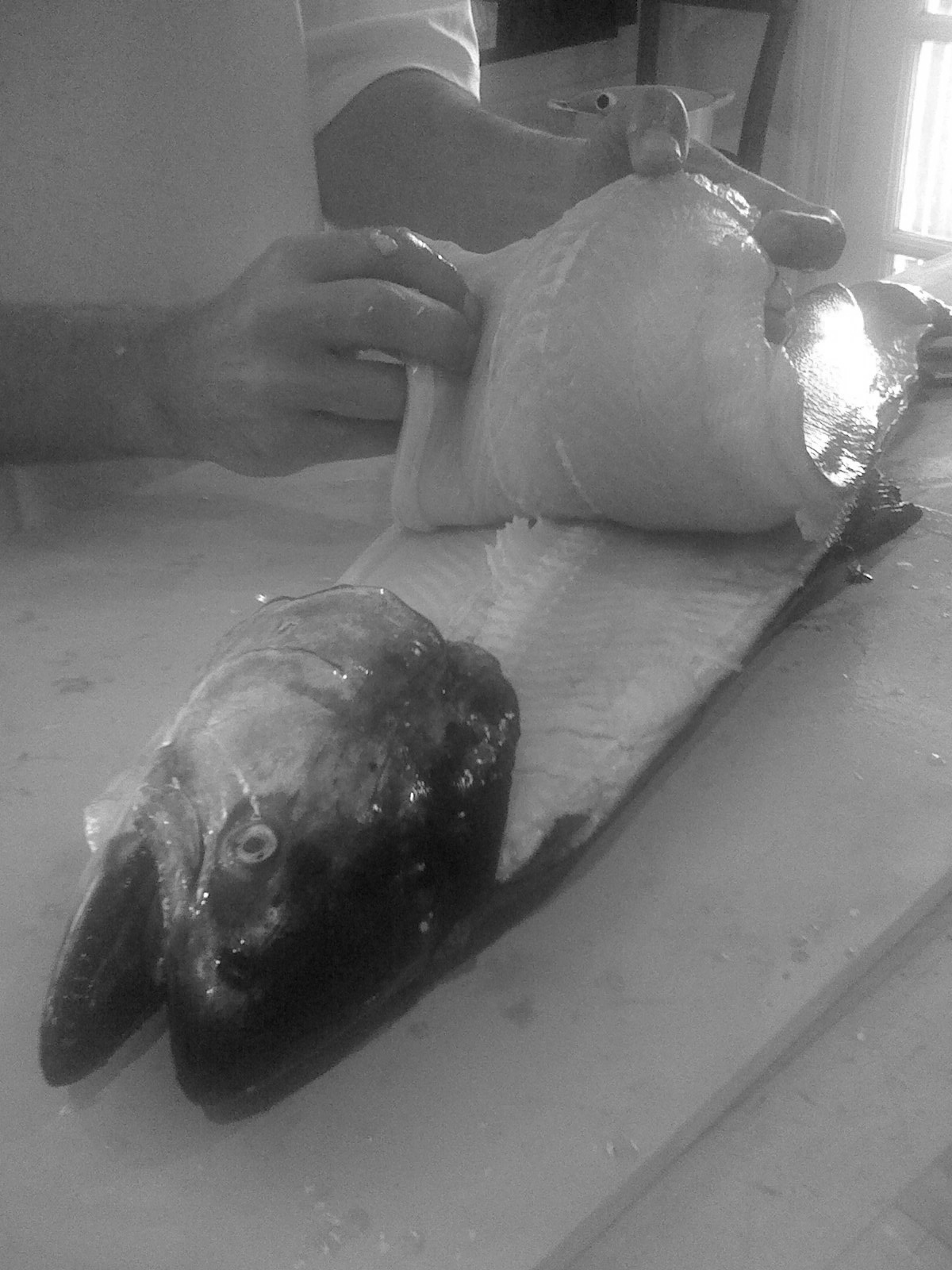
We only serve wild salmon during the salmon season. When writing recipes for various projects I always specify that if using salmon it should be wild. On many occasions I have be asked why is wild salmon superior and is it really worth the money.
Today we received the following information from one of our favorite fish purveyors, Jim at Prime Seafood. Thought this was worth sharing...
Here are 10 reasons to boycott farm-raised salmon:
1. Sea lice -- factory salmon farms are often infested with parasites and spread sea lice to wild salmon and sea trout.
2. Escapes -- a recent scientific paper published by the Royal Society concludes that mass escapes from farms can lead to extinctions in wild salmon.
3. Wastes -- Salmon farms discharge untreated wastes directly into pristine marine waters thereby using the sea as an open sewer.
4. Unsustainable -- far from saving wild fish, salmon farming is a drain on depleted marine resources and is inherently unsustainable.
5. Listeria -- One in ten smoked salmon are contaminated with listeria which can cause meningitis, blood poisoning and still births in pregnant women.
6. Unsanitary and filthy -- the US FDA [Food & Drug Administration] have refused over 200 cases of Irish, Scottish, Chilean and Norwegian salmon for being 'unsanitary' and 'filthy.'
7. Fatty -- Farmed salmon contains more fat than wild salmon (up to ten times fattier in some cases)
8. Chemicals -- Factory farmed salmon are dependent upon a cocktail of toxic chemicals to control diseases and parasites.
9. Artificial colorings -- farmed salmon contain synthetic pink dyes such as Astaxanthin and Canthaxanthin.
10. Cancer-Causing Contaminants -- farmed salmon can contain DDT, chlordane and dioxins and can be up to ten times more contaminated with PCBs [polychlorinated biphenyls] than wild salmon.
Comforting Food

This evening I cooked dinner for a friend and her family in need of comfort. I thought quite a bit about what to cook. In some ways I am completely opposed to this idea of comfort food unless of course the ailment that needs comforting is hunger. Often foods that we turn to for comfort may help us–momentarily distract, but in the long run leave us feeling badly.
Part of the problem with our eating habits is that we have attached the cure of human emotions to foods. The same is true when we use food as a reward. I am not referring to sitting down to a nice meal after a job well done or many calories burned, more about eating an ice cream sundae instead of a single scoop because of a feeling that "I deserve this."
When we are grieving we are outside of ourselves and our sense of self can be lost hence the tendency to not take care of ourselves by over or under eating. In those times a good solid healthy meal can work wonders towards healing both body and mind.
Having someone reach out and prepare a meal for you can be nurturing both nutritionally and emotionally. When my father was sick a chef who was a friend of my mothers prepared us a batch of tapioca pudding. None of us were eating very well and the gesture of the delicious and nurturing pudding helped provide much needed nutrition and simultaneously lifted our spirits. To this day I do not know if the pudding was particularly good but I remember it as one of the most memorable and delicious things I have ever tasted. I know that at different times in my live my senses have been heightened or dulled... the tapioca was important at the time.
In any case I would like to propose a new comfort food, one that takes into account hunger, ingredients and the physical needs and tastes of a particular situation.
Home Lunch Photos
Finding Osage Oranges
 For years I have been enthralled by the funky texture and electric color of a fruit that I find all over the ground in the fall. Every year we bring some home just to look at. This year I have used them for a couple of events and one of the flower wholesalers that I buy from keeps trying to sell them to me since he knows that I like to use non flower elements in my arrangements...I keep telling him I know where to find them.
For years I have been enthralled by the funky texture and electric color of a fruit that I find all over the ground in the fall. Every year we bring some home just to look at. This year I have used them for a couple of events and one of the flower wholesalers that I buy from keeps trying to sell them to me since he knows that I like to use non flower elements in my arrangements...I keep telling him I know where to find them.
For years I incorrectly called them ugly fruit and only recently learned the correct name when a person delivering us organic meat saw a bowl of them on our table a few weeks ago. He told us they were called osage oranges or hedgeapples and had originally been planted to act as barriers before the invent of barbed wire. When I asked if he had ever seen them prepared as food he replied, "I have never seen any animal, not a horse or even a pig eat one."
A quick internet search showed that the wood from the trees is used for its color and texture to make bows, bowls and pens among anything else that needs to be made wooden. This weekend I am going to use them as part of the centerpieces at an event along with leaves and acorns...I have to admit that I get a certain satisfaction from using items I find in the woods within the city that I live. Living in such an advanced form of capitalism, there is something uncanny about the freedom of hunting for an edible mushroom, harvesting from our back yard or picking up an osage orange to use in a flower arrangement.
Home Lunch
We had our first Home Lunch at 1508 on Friday. A fabulous group took time out of their busy day to lunch with us and enjoy each others company. The mood was festive and exhubarant fueled by the fact that everyone deviated from routine, some skipping out of work to join. We look forward to more lunches in the future.
Passing
Egg Salad with Chives
Chestnut Soup with Sage
Fall Squash Gratin
Seared Scallop on Corncake with Mustard Micro Green
Roasted Brussel Sprouts with Pickled Ginger
Sparkling Thyme and Lemon Water
Seated
Beef Bresaola with Radish, Celariac, Asian Pear and Local Greens Dressed with Banyuls Vinagerette
Baked Pasta wit Beets, Baby Turnips and Lima Beans
Chicken Thigh with Burgundy Truffles, Cauliflower Sauce, Brocolli Raab and Sweet Potato
Cave Aged Marissa Cheese with Walnut Cracker and Honeycrisp Apple
Chocolate Torte with Roasted Pear, Frozen Chocolate, Ginger and Cocoa Nibs
Cookies:
Lemon Poppyseed Drops, Gingersnaps, Chocolate Chocoate Chip, Earl Grey Roll Cookies
Truffles
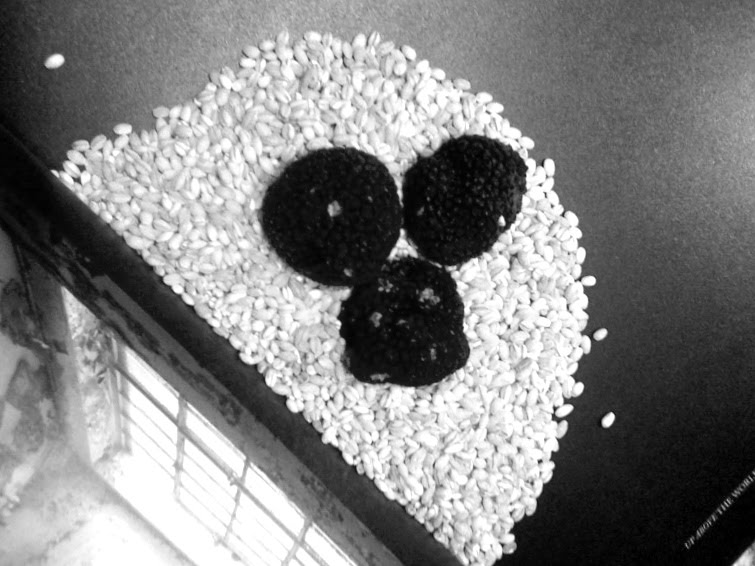 We got our first truffles of the season today through Oregon Mushrooms who we have dealt with over the last couple of years. Truffles are one of the few legendary flavors in my mind that actually live up to the hype. I spoke with Tim on Monday about what types of truffles would be available this week since the season has just begun. He knew that he would have Italian White Alba and Burgundy truffles. On Wednesday Tim called saying that the Oregon truffles were not quite ready for harvest, they would need another few days and that he would have French black truffles in a couple of weeks. We ordered Burgundy truffles which we received this morning.
We got our first truffles of the season today through Oregon Mushrooms who we have dealt with over the last couple of years. Truffles are one of the few legendary flavors in my mind that actually live up to the hype. I spoke with Tim on Monday about what types of truffles would be available this week since the season has just begun. He knew that he would have Italian White Alba and Burgundy truffles. On Wednesday Tim called saying that the Oregon truffles were not quite ready for harvest, they would need another few days and that he would have French black truffles in a couple of weeks. We ordered Burgundy truffles which we received this morning.
Alba White Truffles are the most flavorful of all truffles and also by far the most expensive. We use these shaved fresh over mashed potatoes or cauliflower puree, the warmth from the food sets off the sharp muskiness of the truffles. French Black Perigord truffles and Italian Burgundy truffles are slightly less intense than Alba truffles but are each unique and deeply aromatic. Tomorrow at our Home Lunch we are going to put thin slices of Burgundy truffles under the skin of Eco Friendly Foods chicken and then finish them off with fresh slices on top.
We look forward to getting the Black Oregon truffles soon. They have a vaguely chocolaty taste and are much less expensive than the imported truffles. This allows for experimentation and generous shavings on a variety of foods. Oregon Black truffles are also great in desserts, especially custards and ice cream.
We will incorporate all types of truffles into our menus throughout the winter.
Local Brussel Sprouts
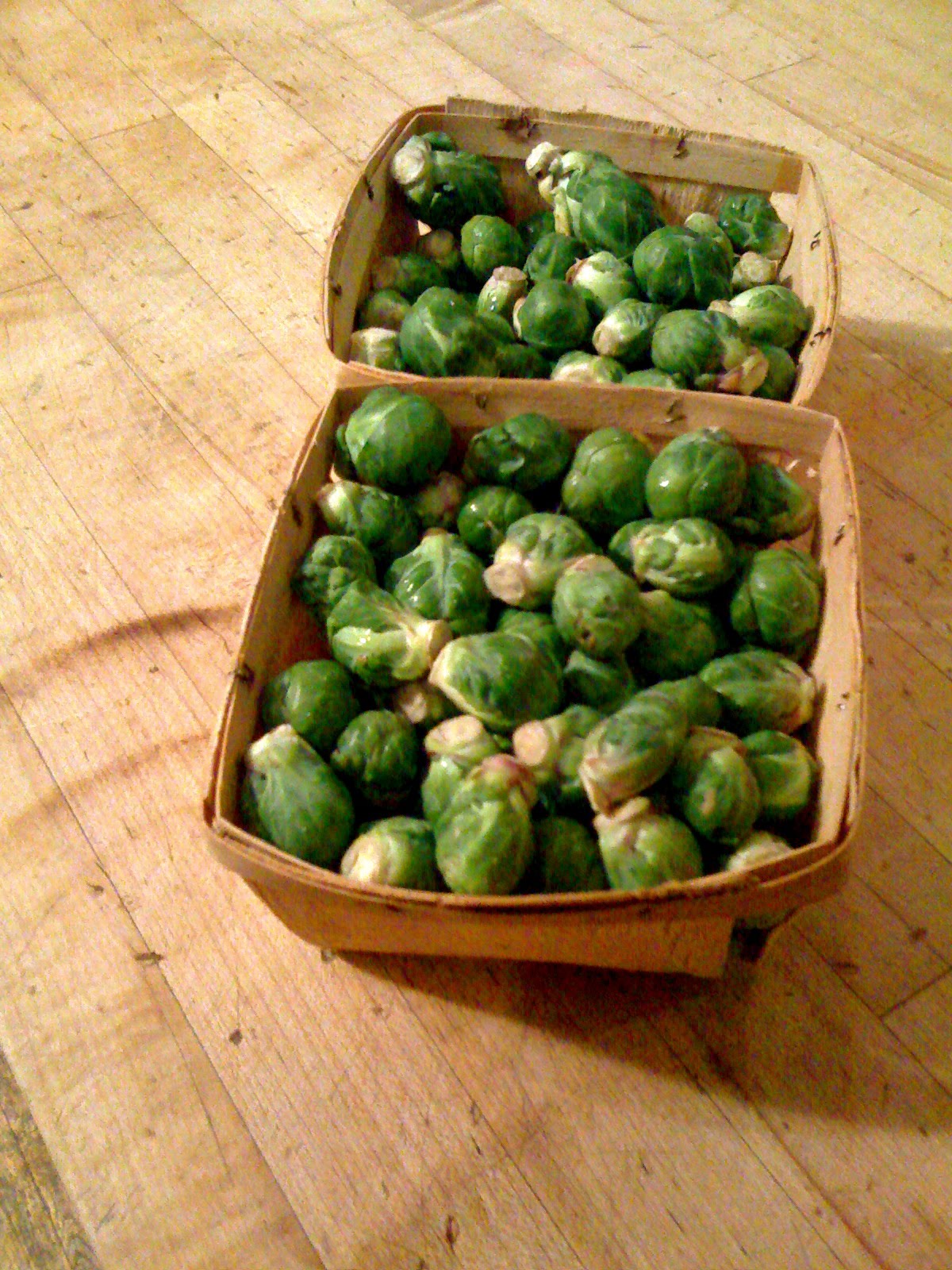 We got the our first local brussel sprouts of the season from Twin Springs Wednesday market. We are going to roast them and pass them at a Home Lunch at 1508 this Friday. Brussel sprouts have a bad reputation because many people think of them as a stinky vegetable. The smell is caused by overcooking. The process of overcooking brussel sprouts actually causes a chemical reaction that emits sulfur which causes both a bitter taste and bad smell.
We got the our first local brussel sprouts of the season from Twin Springs Wednesday market. We are going to roast them and pass them at a Home Lunch at 1508 this Friday. Brussel sprouts have a bad reputation because many people think of them as a stinky vegetable. The smell is caused by overcooking. The process of overcooking brussel sprouts actually causes a chemical reaction that emits sulfur which causes both a bitter taste and bad smell.
On the other hand lightly cooked or raw and marinated brussel sprouts seem unrelated. They often pleasantly surprise people who have previously only eaten overcooked sprouts.
To roast sprouts take a thin slice off the end,where the sprout was attached to the plant, and then cut the sprout in half longways. Heat a heavy bottom skillet over medium high heat. Lightly coat the brussel sprouts in grapeseed oil and season with salt and pepper. Cook cut side down until lightly browned, about 1-2 minutes. Flip the brussel sprout over and cook on the other side until the sprout is just tender, the time will vary from 1-3 minutes depending on the size of the sprout. One of my favorite accompaniments to roasted brussel sprouts is pickled ginger.
To marinate sprouts take a thin slice off the end,where the sprout was attached to the plant, and then cut the sprout in half longways. If the sprouts are very large cut them into quarters. Season sprouts with salt and cover with a vinaigrette of your choice composed of 3 parts vinegar to 1 part oil. One of my favorites is rice wine vinegar and sesame oil. Let the sprouts sit for 30 minutes at room temperature for lightly marinated sprouts or up to 24 hours in the refrigerator.
Micro Greens
The gardening season is winding down. Huge fig leaves are falling and lots of our crops have been pulled up and replaced by green manure. We still have kale, chard, cabbage, tomatoes and horseradish growing...but it seems to be growing in slow motion compared to mid-summer. I relish the change in season and look forward to a little less garden time but already miss just picked from our garden produce...especially salad greens.
In an attempt to keep growing greens throughout the winter we have set up a small micro green farm under a sky light in our house. We hung large window boxes on the wall, fitted them with 8 shallow trays, filled those with a layer of potting soil and sprinkled them with 8 different types of organic seeds. We covered the seeds with paper towels and water them a few times a day with a spray bottle. We planted Friday and the photo is of the seeds yesterday! The greens grow at different rates but some might be ready to eat by this Friday and all will be ready within the month.
We were first introduced to micro greens years ago when Mike Pappas, who had just started Eco Farms showed up at the back door of our restaurant with a variety of enticing micro greens. Immediately we were seduced by the intense flavors and the unique textures and used them to enhance a variety of dishes. Mike grows his greens 8 miles from DC in Lanham Maryland on a small plot of land using bio-intensive farming methods. Years later we are anxious to grow own, experiment with different varieties of greens and use them immediately after harvesting.
Micro greens are packed full of nutrients. It is believed that not only do they contain all of the nutrients of larger greens but also the additional benefits of the energy and nutrients that they would use up in the process of growing larger. They are classified as a functional food, one that provides benefits beyond their basic nutritional profile.
We are excited about our new indoor farming project and hope for success!
Could not resist




We already posted Halloween photos yesterday...but could not resist these fabulous photos that just arrived from Jacqulyn Maisonneuve...Halloween is big around here!
11 Halloweens
Local Fall Dahlias
For the last few weeks I have been using lots of local dahlias. The colors and varieties are vast and make each flower arrangement unique and exciting. The most beautiful dahlias are delicate and do not travel well...luckily Bob Wollam grows a huge variety of dahlias and brings them into DC several times a week. The size of a dahlia flower can range from 2 inches to 1 foot in size. A little research on why there are so many varieties of dahlias revealed that they are octoplodis, meaning that they have eight set of homologous chromosomes instead of the two sets usually found in plants. This gives dahlias 4 times the ability of most other plants to cross breed into different varieties since homologous chromosomes contain hereditary factors such as color, shape, size and petal configuration. New varieties of dahlias are created from both purposeful and accidental (by bees) cross breeding.
Dahlias are available from mid July through the fall. Bob says that he still has lots of flowers blooming, he is able to protect them from light frosts but once a hard frost hits the season will be over.
pumpkin seeds

One of my favorite things to make, serve and eat this time of year is sweet and salty roasted pumpkin seeds. I eat them as a bite on their own, as a garnish to any fall fruit concoction or with pumpkin, sweet potato or squash desserts.
Pumpkin seeds appeal all year long but at this time of year they are at their freshest and pair well with seasonal foods. Over the last couple of weeks we have served them many different ways: roasted and combined with fall squash, in a green salad with banyuls vinaigrette and a quenelle of polyface farm eggs, roasted and added to a spelt bread and to garnish several sweet courses.
I save the seeds from pumpkins and fall squashes to roast, often with olive oil and salt. The unhulled seeds are my favorite for snacking. Hulled pumpkin seeds work well for both savory and sweet dishes.
Nutritionally pumpkin seeds are miraculous! They are believed to help promote prostate health, help with arthritis, and lower cholesterol... They are also full of minerals, protein and monounsaturated fat.
Sweet Roasted Pumpkin Seeds
2 cups Hulled Pumpkin Seeds
3 tablespoons Agave Nectar
Himilayan Salt to taste
1 tablespoon sugar (ideally organic fair trade)
Preheat oven to 350 degrees. On a sheet tray combine pumpkin seeds, agave nectar and salt to taste. Roast stirring regularly until seeds are darkly toasted but not burnt.
Remove from the oven and stir in sugar. Continue stirring as they cool to prevent them from sticking to the sheet tray. These store for several days in an air tight container.
Induction Heat

We just bought a couple induction heat burners to cook tomorrow night in a kitchen that has no stove or oven. My Mother used Cassette Feus, which amounted to fancy French camping stoves or portable butane burners–Barely an upgrade from Sterno. Our new induction heat burners operate on the same technology that a lot of metal work uses. We barely understand and the picture below is the inside of one of our machines. The digital world is frightening sometimes... I mean when something gets hot, I want to see flames... And when something gets Hotter, I want to see bigger Flames! Analog Flames!!
We are looking forward to the gig tomorrow night... Here is a peek at the menu... and the inside of our new machine...
Passing
Roasted Sweet Potato with Polyface Chicken Salad
Seated
Green Salad with Polyface Egg, Chives and Banyuls Vinagrette
Grilled Beef Brisket with Braised Turnip, Carrots Leeks, Potato, Barley and Wilted Chard
(vegetarian alternative available)
Chocolate Cake with Roasted Pears and Ginger
Cookies
Macaroon
Gingersnap
Rosemary Oatmeal


